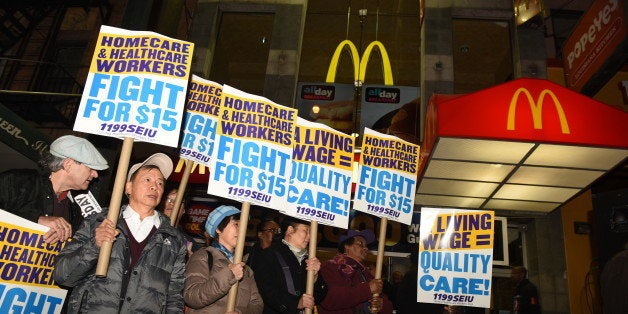
This piece was co-authored by Matt Funiciello is the owner of Rock Hill Bakehouse in Glens Falls, New York and the Green Party Congressional candidate for 21st District of New York in 2014 and 2016.
Beginning on January 1, 2016, the minimum wage in New York rose to $9.00 per hour, a 12 percent increase from 2014. Additionally, the minimum wage for tipped workers increased to $7.50 per hour. Although a minimum wage that rises faster than the cost of living is a good policy to reduce poverty and inequality, small incremental increases over multiple years are not sufficient to keep full-time minimum wage employees out of poverty. A $15 minimum wage is needed today and should be indexed to inflation to ensure that low-wage workers can be economically self-sufficient.
Some upstate New York businesses, especially restaurants that employ mainly tipped workers, are responding by doing away with tipping and switching wait staff to the non-tipped minimum. Paying wait staff and bartenders the non-tipped minimum will reduce the likelihood of these workers living in poverty. But to offset rising labor costs, one restaurant is increasing prices by 18 percent, with the additional revenue distributed by the owners to their employees.
Although consumers might not like paying higher sticker prices, there is no valid argument as to why customers should subsidize business that employ tipped workers at the minimum wage since tipping is no more than a backdoor subsidy to firms by having customers assume part of their labor costs.
Furthermore, taxpayers already heavily subsidize businesses that pay minimum wages, especially in the fast food industry. Since annual incomes for full-time workers earning the minimum wage are near poverty-level, they must rely on income-support programs such as food stamps and health care assistance, programs that are funded by taxpayers. Through these channels, the largest five fast food employers receive nearly $6 billion in taxpayer subsidies.
At the national level, raising the minimum wage to only $10.10 per hour would reduce by almost 2 million the number of people receiving public assistance and reduce spending on these programs by nearly $8 billion. In other words, a minimum wage that is not a living wage costs the public dearly, while benefiting firm owners and executives.
But $10.10 is nowhere near a living wage. If a living wage between $15 and $20--what the minimum wage would be if it kept pace with inflation--was implemented at the federal level and indexed to the cost of living and worker productivity, we would experience wage-led growth, reduced poverty, and less reliance on public support programs. Low-wage workers would become economic engines in our local communities, spurring broad-based growth. With a living wage, business owners would experience higher sales, lower employee turnover, and increased productivity. A living wage is good for workers, good for businesses, and good for taxpayers.
So why isn't the minimum wage a living wage? Political opposition from businesses and groups representing their interests is loud and persuasive, though wholly misguided. Politicians and economists who rely on corporate money surely do not want to bite the hand that feeds them.
Others are misled by their perceptions of who exactly earns the minimum wage. Many people think that minimum wage earners are mostly teenagers working part-time jobs to earn pocket change for summer vacation. The reality is quite different: 88 percent of minimum wage earners are 20 years or older, with an average age of 36, and 57 percent work full-time.
Wouldn't a higher minimum wage raise business costs, leading to lower profits and higher unemployment? Not really. Labor markets can violate the law of demand because businesses can offset higher labor costs in several ways that don't involve layoffs. The first is price increases. But estimates suggest that a minimum wage of $15 per hour would only lead to a 4 percent hike in prices, raising the cost of a cup of coffee at Dunkin' Donuts from around $2 to $2.08. The effects on prices and profits would be minimal because increased costs can be offset by increased productivity due to greater effort, lower turnover (which can save employers $4,700 per employee), and higher sales.
What about the effect on small businesses? Although many might adjust to a higher minimum wage by engaging in layoffs or hours reductions, there are a number of policy options that could reduce the burden on these businesses. Furthermore, other, larger, firms would hire more workers due to the positive effects on sales, productivity, and turnover. Thus, at the firm level there might be instances of job losses in some sectors and job gains in others, but nationwide, there would be no negative net effect or a small positive net effect on employment. Yet Rock Hill Bakehouse (owned by this piece's co-author) pays far in excess of similar businesses pay without engaging in mass layoffs. The average pay for their 35 workers is over $15 per hour, with a range from $12 to $20 for non-tipped staff and $9 plus tips for tipped staff.
Won't business use technology to replace more routinized jobs? Perhaps, as has already been the case at a few nationwide chains. Raising wages obviously affects the calculus of hiring workers, hours, benefits, and buying machines. However, automation began prior to any increases in the minimum wage, and it will ultimately be up to consumers to decide whether automated kiosks are adequate substitutes for human customer service employees.
The minimum wage is far too low for an economy as rich as ours, forcing full-time workers to live in poverty and rely on public support. It's time we end consumer and taxpayer subsidies to businesses that employ minimum wage workers, and make the minimum wage a living wage.
